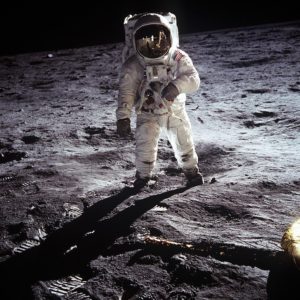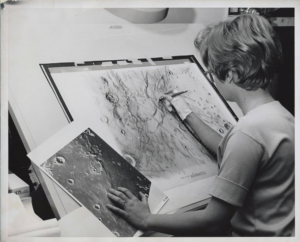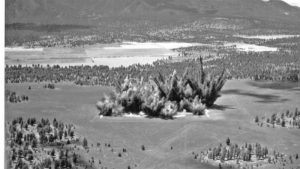
Hi everyone,

Astronaut Buzz Aldrin photographed by Neil Armstrong on the surface of the Moon.
As you probably know, this week marks the 50th anniversary of the Apollo 11 mission that landed Neil Armstrong and Buzz Aldrin on the Moon’s surface on July 20th, 1969. What you might not know, however, is that Lowell Observatory and the city of Flagstaff played key roles in Apollo 11’s success.
Finding a safe place for the lunar module to descend was an important consideration – landing on a boulder or uneven surface and tipping over would have made it impossible for the astronauts to leave the Moon, dooming them to a slow death.

Illustrator Patricia Bridges sketches a map of the Moon at Lowell Observatory circa 1965.
From 1961-1969, artists created airbrushed sketches of the Moon’s surface using Lowell’s Clark Telescope. Starting with photographs of the lunar surface, the artists added fine features that cameras couldn’t capture, producing exquisitely detailed maps of Earth’s companion.
Additionally, every Apollo astronaut that traveled to the Moon visited Flagstaff first. Northern Arizona’s volcanic soil and cratered terrain provided an ideal location for astronauts to practice walking and maneuvering in conditions similar to those they would encounter on the lunar surface. And when natural geological features such as the Grand Canyon and Meteor Crater weren’t enough, scientists detonated explosives to create artificial crater fields.

Detonations to create a crater field near Flagstaff. Image credit: U.S. Geological Survey
I can remember as a young boy watching Neil Armstrong and Buzz Aldrin become the first humans to walk on another world. It’s something I never forgot, despite my siblings and I grumbling to our parents about being forced to stay up past our bedtime to watch grainy images on television. Whether this helped to kindle my love of astronomy and space exploration, who can say?
[vcex_spacing size=”10px”]
If you’d like to know more about Flagstaff’s role in the Apollo missions, just click
here.[vcex_spacing size=”10px”]
And if you’d like to watch/relive the first Moonwalk – all 2.5 hours of it – NASA has remastered the original television broadcast:
[vcex_spacing size=”10px”]
[vcex_spacing size=”10px”]
Best regards,
[vcex_spacing size=”10px”]
Michael
[vcex_spacing size=”10px”]
Dr. Michael West is Lowell Observatory’s Deputy Director for Science. Follow his
AstroAlerts to receive breaking news stories from the world of astronomy, odd bits of astronomical lore, and information about upcoming astronomical events. You can reach him at
mwest@lowell.edu.
You can sign up to have
AstroAlerts delivered right to your inbox by clicking
here. Please share with family and friends! You can also learn about the benefits of Lowell Observatory membership by clicking
here.




